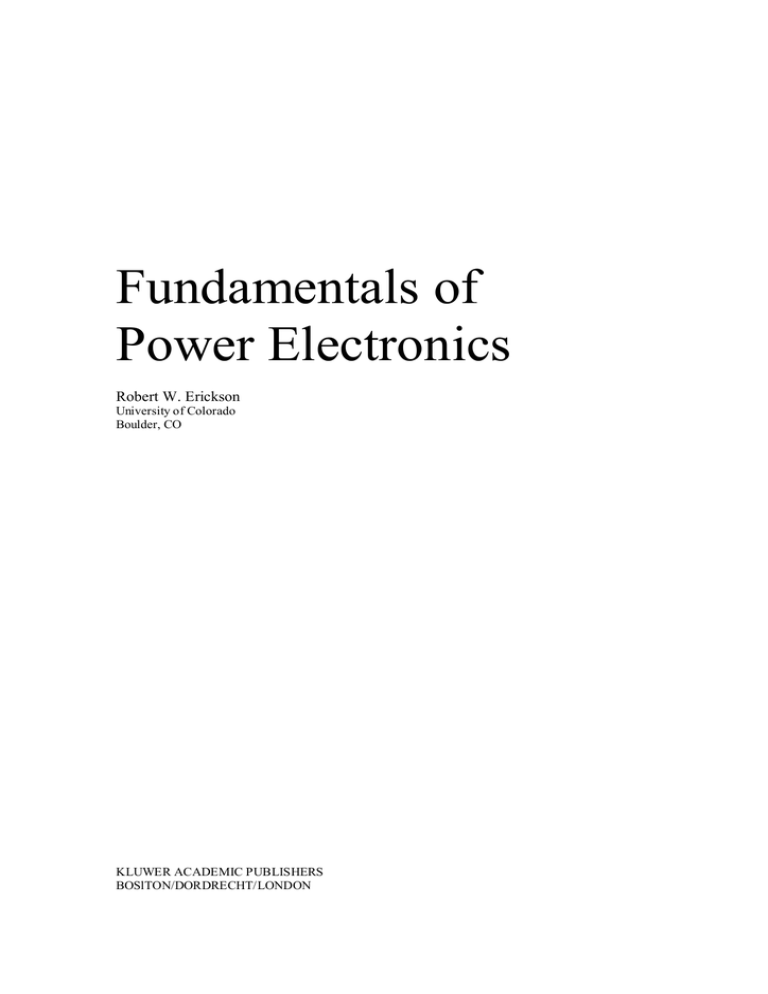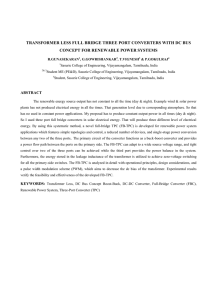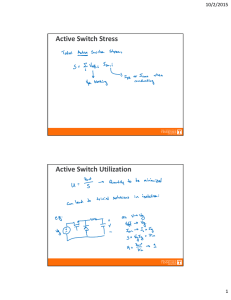
Fundamentals of
Power Electronics
Robert W. Erickson
University of Colorado
Boulder, CO
KLUWER ACADEMIC PUBLISHERS
BOSlTON/DORDRECHT/LONDON
Distributors for North, Central and South Ame rica:
Kluwer Academic Publishers
101 Philip Drive
Assinippi Park
Norwell, Massachusetts 02061 USA
Telephone (781) 871-6600
Fax (781)871-6528
E-Mail kluwer@wkap.com
Distributors for all other countries:
Kluwer Academic Publishers Group
Distribution Centre
Post Office Box 322
3300 AH Dordrecht, THE NETHERLANDS
Telephone 31 78 6392 392
Fax 31 78 6546 474
E-Mail orderdept@wkap.nl
Electronic Services http://www.wkap.nl
Library of Congress Cataloging-in-Publication Data
Erickson, Robert W. (Robert Warren),
Fundamentals of power electronics/Robert W. Erickson
p.
cm.
Includes Bibliographical references and index.
ISBN 0-412-08541-0
1. Power electronics
I.Title
TK7881.
15. E75
1997
621317-dc20
96-38347
CIP
British Library Cataloguing in Publication Data available
Copyright © 1997 by Chapman & Hall
Fifth printing 1999 by Kluwer Academic Publishers
All rights reserved. No part of this publication may be reproduced, stored in a retrieval system or
transmitted in any form or by any means, mechanical, photo-copying, recording, or otherwise, without
the prior written permission of the publisher, Kluwer Academic Publishers, 101 Philip Drive, Assinippi
Park, Norwell, Massachusetts 02061
Printed on acid-free paper.
Printed in the United States of America
Dedicated to
Linda and William
Robert Sr., Pearlie, and Karen
Contents
Dedication
v
Preface
xv
1.
Introduction
1.1. Introduction to Power Processing
1.2. Several Applications of Power Electronics
1.3. Elements of Power Electronics
References
1
1
8
10
11
I.
Converters in Equilibrium
13
2.
Principles of Steady-State Converter Analysis
2.1. Introduction
2.2. Inductor Volt-Second Balance, Capacitor Charge Balance, and the Small-Ripple
Approximation
2.3. Boost Converter Example
2.4. Cuk Converter Example
2.5. Estimating the Output Voltage Ripple in Converters Containing Two-Pole
Low-Pass Filters
2.6. Summary of Key Points
References
Problems
15
15
3.
4.
Steady-State Equivalent Circuit Modeling, Losses, and Efficiency
3.1. The dc Transformer Model
3.2. Inclusion of Inductor Copper Loss
3.3. Construction of Equivalent Circuit Model
3.3.1 Inductor Voltage Equation
3.3.2 Capacitor Current Equation
3.3.3 Complete Circuit Model
3.3.4 Efficiency
3.4. How to Obtain the Input Port of the Model
3.5. Example: Inclusion of Semiconductor Conduction Losses in the Boost
Converter Model
3.6. Summary of Key Points
References
Problems
Switch Realization
4.1. Switch Applications
4.1.1. Single-Quadrant Switches
4.1.2. Current-Bidirectional Two-Quadrant Switches
4.1.3. Voltage-Bidirectional Two-Quadrant Switch
4.1.4. Four-Quadrant Switches
4.1.5. Synchronous Rectifiers
4.2. A Brief Survey of Power Semiconductor Devices
4.2.1. Power Diodes
4.2.2. Metal-Oxide-Semiconductor Field-Effect Transistor (MOSFET)
4.2.3. Bipolar Junction Transistor (BJT)
4.2.4. Insulated Gate Bipolar Transistor (IGBT)
4.2.5. Thyristors (SCR, GTO, MCT)
4.3. Switching Loss
4.3.1. Transistor Switching with Clamped Inductive Load
4.3.2. Diode Recovered Charge
4.3.3. Device Capacitances, and Leakage, Package, and Stray Inductances
17
24
29
34
36
36
37
40
40
43
46
47
47
48
49
51
53
57
58
58
62
64
64
67
70
71
73
74
75
78
82
87
89
94
94
97
100
4.3.4 Efficiency vs. Switching Frequency
4.4. Summary of Key Points
References
Problems
103
104
105
106
5.
The Discontinuous Conduction Mode
5.1. Origin of the Discontinuous Conduction Mode, and Mode Boundary
5.2. Analysis of the Conversion Ratio M(D, K)
5.3. Boost Converter Example
5.4. Summary of Results and Key Points
Problems
110
111
115
121
127
129
6.
Converter Circuits
6.1. Circuit Manipulations
6.1.1. Inversion of Source and Load
6.1.2. Cascade Connection of Converters
6.1.3. Rotation of Three-Terminal Cell
6.1.4. Differentia Connection of the Load
6.2. A Short List of Converters
6.3. Transformer Isolation
6.3.1. Full-Bridge and Half-Bridge Isolated Buck Converters
6.3.2. Forward Converter
6.3.3. Push-Pull Isolated Buck Converter
6.3.4. Flyback Converter
6.3.5. Boost-Derived Isolated Converters
6.3.6. Isolated Versions of the SEPIC and the Cuk Converter
6.4. Converter Evaluation and Design
6.4.1. Switch Stress and Utilization
6.4.2. Design Using Computer Spreadsheet
6.5. Summary of Key Points
References
Problems
135
136
136
138
141
142
146
150
154
159
164
166
171
174
177
177
180
183
183
185
II. Converter Dynamics and Control
191
7.
193
193
198
199
200
202
203
204
207
208
209
218
218
221
223
227
231
234
235
235
239
245
245
AC Equivalent Circuit Modeling
7.1. Introduction
7.2. The Basic ac Modeling Approach
7.2.1. Averaging the Inductor Waveforms
7.2.2. Discussion of the Averaging Approximation
7.2.3. Averaging the Capacitor Waveforms
7.2.4. The Average Input Current
7.2.5. Perturbation and Linearization
7.2.6. Construction of the Small-Signal Equivalent Circuit Model
7.2.7. Results for Several Basic Converters
7.3. Example: A Nonideal Flyback Converter
7.4. State-Space Averaging
7.4.1. The State Equations of a Network
7.4.2. The Basic State-Space Averaged Model
7.2.3. Discussion of the State-Space Averaging Result
7.2.4. Example: State-Space Averaging of a Nonideal Buck-Boost Converter
7.5. Circuit Averaging and Averaged Switch Modeling
7.5.1. Obtaining a Time-Invariant Circuit
7.5.2. Circuit Averaging
7.5.3. Perturbation and Linearization
7.5.4. Averaged Switch Modeling
7.6. The Canonical Circuit Model
7.6.1. Development of the Canonical Circuit Model
7.6.2. Example: Manipulation of the Buck-Boost Converter Model
into Canonical Form
248
7.6.3. Canonical Circuit Parameter Values for Some Common Converters
7.7. Modeling the Pulse-Width Modulator
7.8. Summary of Key Points
References
Problems
251
252
254
255
255
8.
Converter Transfer Functions
8.1. Review of Bode Plots
8.1.1. Single Pole Response
8.1.2. Single Zero Response
8.1.3. Right Half-Plane Zero
8.1.4. Frequency Inversion
8.1.5. Combinations
8.1.6. Quadratic Pole Response: Resonance
8.1.7. The Low-Q Approximation
8.1.8. Approximate Roots of an Arbitrary-Degree Polynomial
8.2. Analysis of Converter Transfer Functions
8.2.1. Example: Transfer Functions of the Buck-Boost Converter
8.2.2. Transfer Functions of Some Basic CCM Converters
8.2.3. Physical Origins of the RHP Zero in Converters
8.3. Graphical Construction of Converter Transfer Functions
8.3.1. Series Impedances: Addition of Asymptotes
8.3.2. Parallel Impedances: Inverse Addition of Asymptotes
8.3.3. Another Example
8.3.4. Voltage Divider Transfer Functions: Division of Asymptotes
8.4. Measurement of AC Transfer Functions and Impedances
8.5. Summary of Key Points
References
Problems
261
262
263
268
269
271
272
276
282
285
289
289
292
294
2%
296
296
303
307
309
314
315
315
9.
Controller Design
9.1. Introduction
9.2. Effect of Negative Feedback on the Network Transfer Functons
9.2.1. Feedback Reduces the Transfer Functions from Disturbances to the Output
9.2.2. Feedback Causes the Transfer Function from the Reference Input to the
Output to be Insensitive to Variations in the Gains in the Forward Path of
the Loop
9.3. Construction of the Important Quantities 1/(1 + T) and T/(1 + T) and the
Closed-Loop Transfer Functions
9.4. Stability
9.4.1. The Phase Margin Test
9.4.2. The Relation Between Phase Margin and Closed-Loop Damping Factor
9.4.3. Transient Response vs. Damping Factor
9.5. Regulator Design
9.5.1. Lead (PD) Compensator
9.5.2. Lag (PI) Compensator
9.5.3. Combined (PID) Compensator
9.5.4. Design Example
9.6. Measurement of Loop Gains
9.6.1. Voltage Injection
9.6.2. Current Injection
9.6.3. Measurement of Unstable Systems
9.7. Summary of Key Points
References
Problems
323
323
326
327
10. Ac and dc Equivalent Circuit Modeling of the Discontinuous Conduction Mode
10.1. DCM Averaged Switch Model
10.2. Small-Signal AC Modeling of the DCM Switch Network
10.3. Generalized Switch Averaging
329
329
332
333
334
338
339
340
343
345
346
355
357
359
360
361
361
362
369
370
382
390
10.3.1. DCM Buck Converter Example
10.3.2. Proof of Generalized Averaged Switch Modeling
10.4. Summary of Key Points
References
Problems
393
399
403
404
405
11. Current Programme d Control
11.1. Oscillation for D > 0.5
11.2. A Simple First-Order Model
11.2.1. Simple Model via Algebraic Approach: Buck-Boost Example
11.2.2. Averaged Switch Modeling
11.3. A More Accurate Model
11.3.1. Current Programmed Controller Model
11.3.2. Example: Analysis of CPM Buck Converter
11.4. Discontinuous Conduction Mode
11.5. Summary of Key Points
References
Problems
408
411
418
419
423
428
428
431
438
447
448
449
III. Magnetics
453
12. Basic Magnetics Theory
12.1. Review of Basic Magnetics
12.1.1. Basic Relationships
12.1.2. Magnetic Circuits
12.2. Transformer Modeling
12.2.1. The Ideal Transformer
12.2.2. The Magnetizing Inductance
12.2.3. Leakage Inductances
12.3. Loss Mechanisms in Magnetic Devices
12.3.1. Core Loss
12.3.2. Low-Frequency Copper Loss
12.4. Eddy Currents in Winding Conductors
12.4.1. The Skin Effect
12.4.2. The Proximity Effect
12.4.3. Magnetic Fields in the Vicinity of Winding Conductors: MMF Diagrams
12.4.4. Power Loss in a Layer
12.4.5. Example: Power Loss in a Transformer Winding
12.4.6. PWM Waveform Harmonics
12.5. Summary of Key Points
References
455
455
455
463
466
467
468
469
471
471
474
474
475
476
479
482
483
487
490
491
13. Filter Inductor Design
13.1 Several Types of Magnetic Devices, Their B-H Loops, and Core vs. Copper Loss
13.1.1. Filter Inductor
13.1.2. Ac Inductor
13.1.3. Transformer
13.1.4. Coupled Inductor
13.1.5. Flyback Transformer
13.2. Filter Inductor Design Constraints
13.2.1. Maximum Flux Density
13.2.2. Inductance
13.2.3. Winding Area
13.2.4. Winding Resistance
13.3. The Core Geometrical Constant Kg
13.4. A Step-by-Step Procedure
13.4.1. Procedure
13.5. Summary of Key Points
References
Problems
497
497
497
499
500
501
502
503
506
506
506
507
507
508
509
509
510
510
14. Transformer Design
14.1. Winding Area Optimization
14.2 Transformer Design: Basic Constraints
14.2.1. Core Loss
14.2.2. Flux Density
14.2.3. Copper Loss
14.2.4. Total Power Loss vs. Bmax
14.2.5. Optimum Flux Density
14.3. A Step-by-Step Transformer Design Procedure
14.3.1 Procedure
14.4. Examples
14.4.1. Example 1: Single-Output Isolated Cuk Converter
14.4.2. Example 2: Multiple-Output Full-Bridge Buck Converter
14.5. Ac Inductor Design
14.5.1 Outline of Derivation
14.5.2 Step-by-Step AC Inductor Design Procedure
14.6. Summary
References
Problems
512
513
517
518
518
519
520
520
521
522
524
524
528
531
532
533
534
535
535
IV. Modern Rectifiers and Power System Harmonics
539
15. Power and Harmonics in Nonsinusoidal Systems
15.1. Average Power
15.2. Root-Mean-Square (RMS) Value of a Waveform
15.3. Power Factor
15.3.1. Linear Resistive Load, Nonsinusoidal Voltage
15.3.2. Nonlinear Dynamical Load, Sinusoidal Voltage
15.4. Power Phasors in Sinusoidal Systems
15.5. Harmonic Currents in Three-Phase Systems
15.5.1. Harmonic Currents in Three-Phase Four-Wire Networks
15.5.2. Harmonic Currents in Three-Phase Three-Wire Networks
15.5.3. Harmonic Current How in Power Factor Correction Capacitors
15.6. AC Line Current Harmonic Standards
15.6.1. US MIL-STD-461B
15.6.2. International Electrotechnical Commission Standard 555
15.6.3. IEEE/ANSI Standard 519
References
Problems
541
542
543
546
546
547
550
551
552
553
554
555
556
556
557
16. Line-Commutated Rectifiers
16.1. The Single-Phase Full-Wave Rectifier
16.1.1. Continuous Conduction Mode
16.1.2 Discontinuous Conduction Mode
16.1.3. Behavior When C is Large
16.1.4. Minimizing THD When C is Small
16.2. The Three-Phase Bridge Rectifier
16.2.1. Continuous Conduction Mode
16.2.2. Discontinuous Conduction Mode
16.3. Phase Control
16.3.1. Inverter Mode
16.3.2. Harmonics and Power Factor
16.3.3. Commutation
16.4. Harmonic Trap Filters
16.5. Transformer Connections
16.6. Summary
References
Problems
562
562
563
564
565
566
568
569
569
570
572
573
573
575
582
583
585
586
17. The Ideal Rectifier
17.1. Properties of the Ideal Rectifier
17.2. Realization of a Near-Ideal Rectifier
17.3. Single-Phase Converter Systems Incorporating Ideal Rectifiers
17.4. RMS Values of Rectifier Waveforms
17.4.1. Boost Rectifier Example
17.4.2. Comparison of Single-Phase Rectifier Topologies
17.5. Ideal Three-Phase Rectifiers
17.5.1. Three-Phase Rectifiers Operating in CCM
17.5.2. Some Other Approaches to Three-Phase Rectification
17.6. Summary of Key Points
References
Problems
590
590
593
599
604
605
608
608
611
615
622
622
624
18. Low Harmonic Rectifier Modeling and Control
18.1. Modeling Losses and Efficiency in CCM High-Quality Rectifiers
18.1.1. Expression for Controller Duty Cycle d(t)
18.1.2. Expression for the dc Load Current
18.1.3. Solution for Converter Efficiency
18.1.4. Design Example
18.2. Controller Schemes
18.2.1. Average Current Control
18.2.2. Feedforward
18.2.3. Current Programmed Control
18.2.4. Hysteretic Control
18.2.5. Nonlinear Carrier Control
18.3. Control System Modeling
18.3.1. Modeling the Outer Low-Bandwidth Control System
18.3.2. Modeling the Inner Wide-Bandwidth Average Current Controller
18.4. Summary of Key Points
References
Problems
627
627
628
629
632
634
634
634
635
636
639
641
645
645
650
652
652
653
V. Resonant Converters
657
19. Resonant Conversion
19.1. Sinusoidal Analysis of Resonant. Converters
19.1.1. Controlled Switch Network Model
19.1.2. Modeling the Rectifier and Capacitive Filter Networks
19.1.3. Resonant Tank Network
19.1.4. Solution of Converter Voltage Conversion Ratio M=V/Vg
19.2. Examples
19.2.1. Series Resonant dc-dc Converter Example
19.2.2. Subharmonic Modes of the Series Resonant Converter
19.2.3. Parallel Resonant dc-dc Converter Example
19.3. Exact Characteristics of the Series and Parallel Resonant Converters
19.3.1. Series Resonant Converter
19.3.2. Parallel Resonant Converter
19.4. Soft Switching
19.4.1. Operation of the Full Bridge Below Resonance: Zero Current Switching
19.4.2. Operation of the Full Bridge Above Resonance: Zero Voltage Switching
19.4.3. The Zero Voltage Transition Converter
19.5. Load-Dependent Properties of Resonant Converters
19.5.1. Inverter Output Characteristics
19.5.2. Dependence of Transistor Current on Load
19.5.3. Dependence of the ZVS/ZCS Boundary on Load Resistance
19.6. Summary of Key Points
References
Problems
659
664
664
666
668
670
670
670
673
674
678
679
686
689
690
692
695
697
699
699
702
705
705
707
20. Quasi-Resonant Converters
20.1. The Zero-Current-Switching Quasi-Resonant Switch Cell
20.1.1. Waveforms of the Half-Wave ZCS Quasi-Resonant Switch Cell
20.1.2. The Average Terminal Waveforms
20.1.3. The Full-Wave ZCS Quasi-Resonant Switch Cell
20.2. Resonant Switch Topologies
20.2.1. The Zero-Voltage-Switching Quasi-Resonant Switch
20.2.2. The Zero-Voltage-Switching Multi-Resonant Switch
20.2.3. Quasi-Square-Wave Resonant Switches
20.3. AC Modeling of Quasi-Resonant Converters
20.4. Summary of Key Points
References
Problems
711
712
714
718
723
724
726
729
730
732
737
737
738
Appendices
741
Appendix 1. RMS Values of Commonly-Observed Converter Waveforms
A.1.1. Some Common Waveforms
A 1.2. General Piecewise Waveform
743
743
747
Appendix 2. Magnetics design tables
A2.1.
Pot core data
A2.2.
EE core data
A2.3.
EC core data
A2.4.
ETD core data
A2.5.
PQ core data
A2.6.
American wire gauge data
References
751
752
753
754
754
755
755
756
Appemdix 3. Averaged Switch Modeling of a CCM SEPIC
757
Index
763




